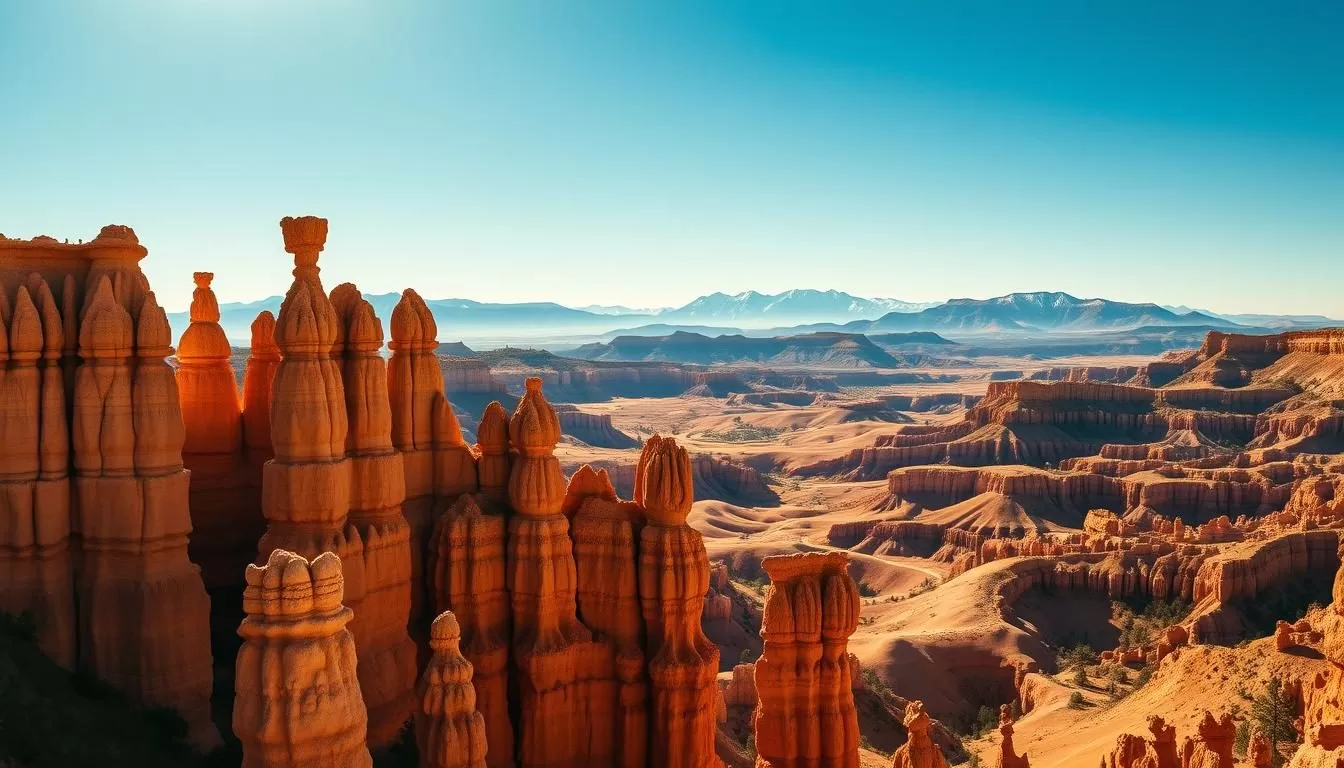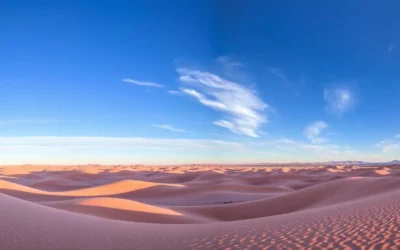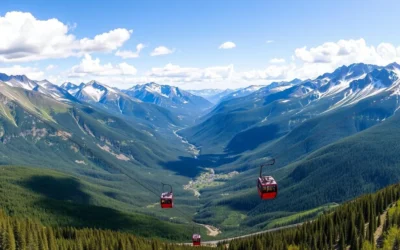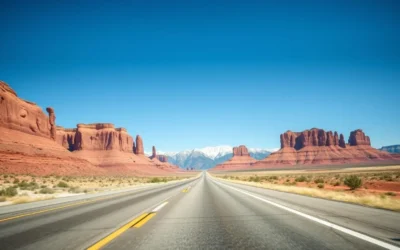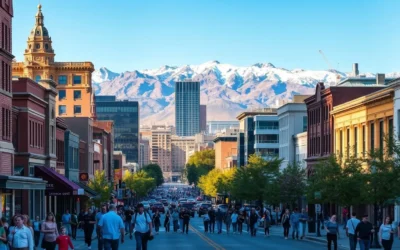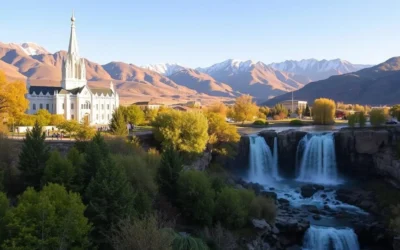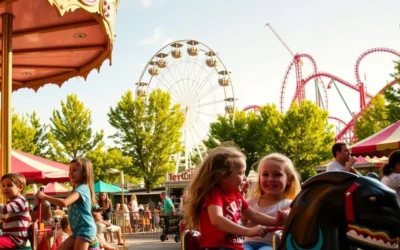✓ Accommodations ✓ Flights ✓ Rental Cars ✓ Tours & Activities
Welcome to one of Utah’s most spectacular natural wonders, home to the largest concentration of hoodoos on Earth.
As you visit this remarkable national park, you’ll experience world-class scenery and stargazing opportunities.
The park’s distinctive red rock formations, created by centuries of erosion and weathering, create an otherworldly landscape that changes dramatically with the light throughout the day.
With only about two million visitors annually, canyon national park offers a more intimate experience with nature.
This guide will help you make the most of your visit, whether you’re planning a quick trip or an extended stay.
Discovering the Magic of Bryce Canyon National Park
As you step into Bryce Canyon National Park, you’ll be transported to a world of breathtaking beauty. This natural wonder is unlike any other, with its distinctive landscape that has captivated visitors from around the world.
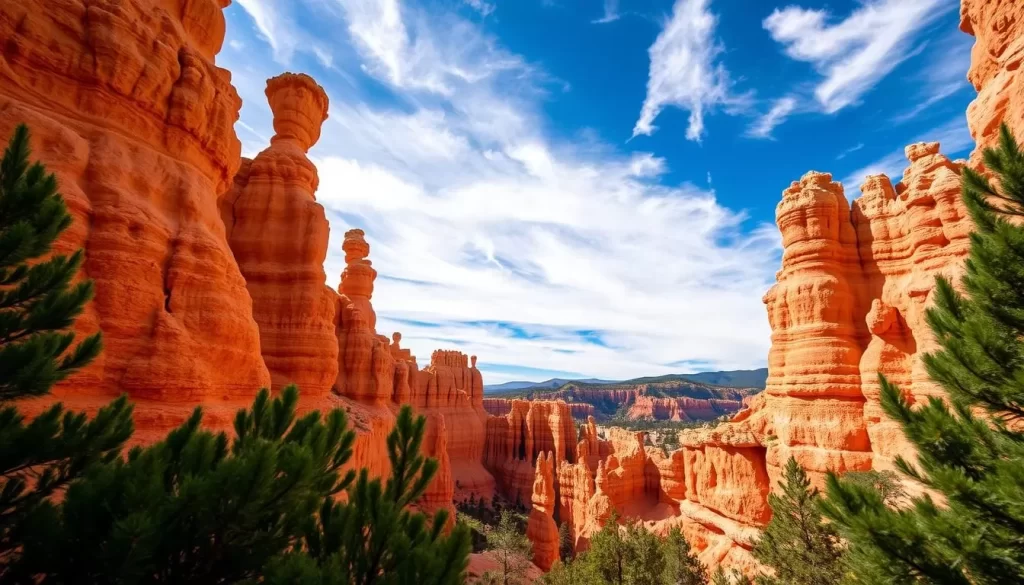
What Makes Bryce Canyon Special
Bryce Canyon National Park isn’t just a natural marvel; it’s a series of natural amphitheaters carved into the edge of the Paunsaugunt Plateau. What truly sets it apart from other national parks in Utah is its concentration of hoodoos – tall, thin spires of rock that protrude from the bottom of arid basins. The park’s unique geological features were formed through a process called “frost-wedging,” where water seeps into cracks, freezes, and expands, gradually breaking apart the rock.
The elevation of Bryce Canyon ranges from 8,000 to 9,000 feet, providing a cooler climate than nearby parks and creating the perfect conditions for hoodoo formation. The vibrant colors of the rock formations, ranging from deep reds to bright oranges and whites, come from minerals in the limestone that oxidize when exposed to air.
Understanding the Unique Hoodoo Formations
The hoodoos in Bryce Canyon National Park are a result of weathering and erosion, including snow and ice melt that allows water to seep into fractures in the rock, refreezing and expanding. They start from a thin wall of rock, in which frost and ice eventually create “holes” or “windows” within the wall. From there, the “top” of the window eventually gives way, separating the wall into limestone spires called “hoodoos.”
These rock formations occur on every continent, but at Bryce, you’ll see the largest concentration of hoodoos in the world. It’s truly like stepping onto another planet! The Native Paiute Indians who lived in the area described the hoodoos as “legend people” who had been turned to stone by an angry coyote god.
Best Time to Visit Bryce Canyon National Park
Whether you’re looking for pleasant hiking weather or a serene, snow-covered landscape, Bryce Canyon National Park has a season that’s perfect for you. Located atop a mesa above 9,100 ft., the park experiences a range of climates throughout the year.
Seasonal Highlights and Weather Considerations
Bryce Canyon is open year-round, offering a unique experience with each season. In the spring (March-May), moderate temperatures and blooming wildflowers make it an attractive time to visit, though higher elevations may still have snow.
Summer (June-August) brings warmer temperatures, often reaching the 80s during the day, but it’s also the peak tourist season with the highest number of visitors. Autumn (September-October) offers pleasant weather with fewer crowds, ideal for hiking and photography as the changing light enhances the hoodoos.
![]()
Avoiding Crowds: Peak vs. Off-Peak Times
To avoid the crowds, consider visiting during the off-season or early in the morning. Weekdays are generally less crowded than weekends. The sunrise and sunset times are particularly popular for photography due to the dramatic shadows and intensified colors of the hoodoos.
Visiting during the spring or fall can provide a more serene experience. If you’re prepared for cold weather, winter can also be a peaceful time to explore Bryce Canyon National Park, with the snow-covered landscape offering a unique beauty.
Getting to and Around Bryce Canyon
To experience the natural beauty of Bryce Canyon, you’ll need to know how to get there and how to get around.
Transportation Options to Reach the Park
Bryce Canyon National Park is easily accessible by car from major cities like Las Vegas and Salt Lake City, which are approximately 270 miles away, about a four-hour drive. The park is laid out along an 18-mile scenic drive (Highway 63) that runs north to south, with most major viewpoints and trailheads located along this main road.
| Starting City | Distance to Bryce Canyon | Drive Time |
|---|---|---|
| Las Vegas | 270 miles | 4 hours |
| Salt Lake City | 270 miles | 4 hours |
Navigating Within Bryce Canyon: Shuttle System and Driving Tips
During peak season (May through September), afree shuttle serviceoperates, connecting the Bryce Canyon City area with popular destinations within the park. This service helps reduce traffic congestion and makes it easier to enjoy the park’s attractions without the hassle of parking. The shuttle makes stops at all major viewpoints and trailheads in the Bryce Amphitheater area, includingSunrise Point, Sunset Point, Inspiration Point, and Bryce Point. For those driving their own vehicles, parking is available at the Visitor Center and at major viewpoints.

Essential Information for Your Visit
Before you head to Bryce Canyon, getting the right information about entrance fees, visitor center services, and safety tips will enhance your experience. Understanding these essentials will help you plan a more enjoyable and stress-free trip to Bryce Canyon National Park.
Entrance Fees and Passes
The entrance fee for Bryce Canyon National Park is $35 per car for a seven-day pass. You can also opt for an annual pass for $70. If you’re visiting with a motorcycle, the seven-day pass is $30. Senior citizens have the option to purchase a lifetime senior pass for $80, which covers all national parks, or an annual pass for $20. Active military members, veterans, and Gold Star families can obtain a free pass. If you plan to visit more than two national parks in a year, consider the America the Beautiful annual pass for $80, which grants access to multiple national parks.
- The standard entrance fee is $35 per vehicle, valid for seven days.
- Special passes are available for seniors, military members, veterans, Gold Star families, and fourth-grade students through the Every Kid Outdoors program.
- If you plan to visit multiple national parks, the $80 America the Beautiful annual pass offers significant savings.
Visitor Center Services
The Visitor Center is your first stop upon entering Bryce Canyon National Park. Here, you can view exhibits about the park’s geology, pick up maps, and check current trail conditions. Rangers at the Visitor Center provide information about ranger-led programs, including guided hikes, geology talks, and evening astronomy programs.

Safety Tips and Park Regulations
Safety is paramount when exploring Bryce Canyon. The high elevation (8,000-9,000 feet) means visitors should stay hydrated, protect against sun exposure, and be aware of potential altitude sickness. Weather conditions can change rapidly, so dress in layers and be prepared for afternoon thunderstorms in summer and snow or ice in winter.
- Stay hydrated and protected against sun exposure due to the high elevation.
- Be aware of and comply with park regulations, such as not feeding wildlife, not collecting rocks or plants, and staying on established trails.
- Dress in layers and be prepared for changing weather conditions.
By understanding and following these guidelines, you can ensure a safe and enjoyable visit to Bryce Canyon National Park.
Hiking the Iconic Navajo Loop Trail
![]()
Experience the iconic Navajo Loop Trail, a 1.5-mile loop that descends into the heart of Bryce Canyon National Park. This moderately difficult trail is a must-see for any visitor, offering an immersive experience among the park’s unique hoodoo formations.
Trail Overview and Difficulty Level
The Navajo Loop Trail is a 1.5-mile loop that begins and ends at Sunset Point, descending approximately 515 feet into the canyon through a series of switchbacks. The trail is considered moderately difficult due to the steep switchbacks, which can be challenging, especially on the ascent.
It’s essential to pace yourself and bring plenty of water, particularly during hot summer months. The trail can be hiked in either direction, but hiking clockwise will take you down through Wall Street‘s dramatic slot canyon.
Highlights and What to Expect
The Navajo Loop Trail features several notable landmarks, including Thor’s Hammer, a distinctive hoodoo with a balanced rock on top, and Two Bridges. The trail also takes you through Wall Street, a narrow slot canyon with towering walls.
Early morning is the best time to hike the Navajo Loop to avoid crowds and take advantage of cooler temperatures and beautiful lighting for photography. The trail can be combined with the Queen’s Garden Trail to create a more extensive 2.9-mile figure-eight loop.
In winter, the trail may be covered in snow and ice, making microspikes or similar traction devices essential for safety. Be aware that the section through Wall Street is often closed in winter due to falling ice and rock hazards.
Exploring the Queen’s Garden Trail
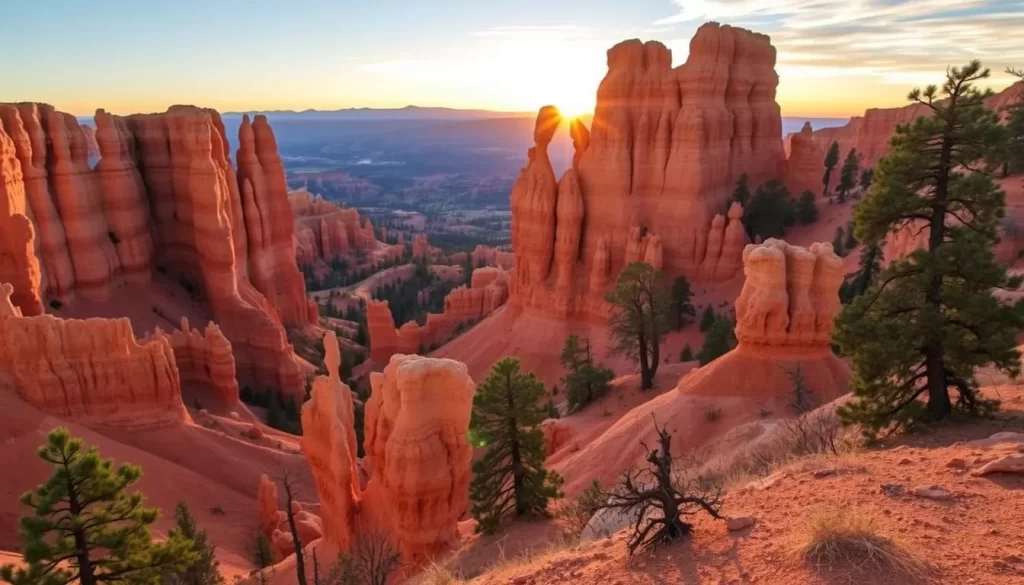
Meandering through the Bryce Canyon Amphitheater, the Queen’s Garden Trail is a scenic hike that showcases the park’s natural beauty. This trail is one of the most beautiful day hikes in Bryce Canyon National Park, offering an experience that is both memorable and accessible.
Trail Features and Route Options
The Queen’s Garden Trail is often described as the least strenuous path into the canyon, making it an excellent choice for families and those seeking a moderately easy hike among the hoodoos. This 1.8-mile roundtrip trail begins at Sunrise Point and descends approximately 320 feet into the canyon, offering spectacular views of the colorful rock formations along the way. The trail’s name comes from a hoodoo formation that resembles Queen Victoria sitting on her throne, which you can find near the end of the trail.
The trail features numerous viewpoints and photo opportunities, so allow extra time if photography is a priority during your hike. While beautiful year-round, the Queen’s Garden Trail is particularly stunning in early morning light when the rising sun illuminates the hoodoos with a warm, golden glow.
Combining with Other Trails for the Perfect Loop
For a more comprehensive experience, many hikers combine the Queen’s Garden Trail with the Navajo Loop to create a 2.9-mile figure-eight loop that showcases the best of the Bryce Amphitheater. When combining trails, consider starting at Sunrise Point, descending via Queen’s Garden, connecting to the Navajo Loop, and returning to Sunset Point – then use the Rim Trail to return to your starting point.
Like all trails in Bryce Canyon, the Queen’s Garden can have varying conditions depending on the season – expect mud in spring, hot temperatures in summer, and potentially snow and ice in winter. Planning your hike according to the season will enhance your experience.
Must-Visit Viewpoints in Bryce Canyon National Park, Utah: Best Things to Do – Top Picks
As you explore Bryce Canyon National Park, you’ll discover a series of must-visit viewpoints that showcase the park’s natural beauty from various perspectives. The park features several viewpoints that are considered top picks for their breathtaking views and unique experiences.
Sunrise and Sunset Points
Sunrise Point and Sunset Point are two of the most popular viewpoints in Bryce Canyon. Sunrise Point offers spectacular eastern views across the amphitheater, making it an ideal location to watch the morning sun illuminate the hoodoos with golden light. It’s also the trailhead for the Queen’s Garden Trail. On the other hand, Sunset Point, just a half-mile walk from Sunrise Point along the Rim Trail, provides dramatic views of Thor’s Hammer and serves as the trailhead for the popular Navajo Loop Trail.
Inspiration Point and Bryce Point
Inspiration Point offers three different viewing levels, with the upper viewpoint providing the most expansive panorama of the main amphitheater. Arriving early in the morning can help you avoid crowds and capture dramatic lighting. Bryce Point, at 8,296 feet elevation, offers perhaps the most spectacular and comprehensive view of the amphitheater, making it an excellent choice for both sunrise and sunset photography despite its name.
| Viewpoint | Elevation | Notable Features |
|---|---|---|
| Sunrise Point | 8,000 ft | Eastern views, Queen’s Garden Trailhead |
| Sunset Point | 8,000 ft | Dramatic views of Thor’s Hammer, Navajo Loop Trailhead |
| Inspiration Point | 8,100 ft | Three viewing levels, expansive panorama |
| Bryce Point | 8,296 ft | Comprehensive view, sunrise and sunset photography |
Rainbow and Yovimpa Points
Rainbow Point, at the southern end of the park’s 18-mile scenic drive, sits at the highest elevation (9,115 feet) and offers views extending up to 100 miles on clear days. Adjacent to Rainbow Point, Yovimpa Point provides unique views looking south toward the Grand Staircase and the North Rim of the Grand Canyon in the distance.
The Scenic Rim Trail Experience
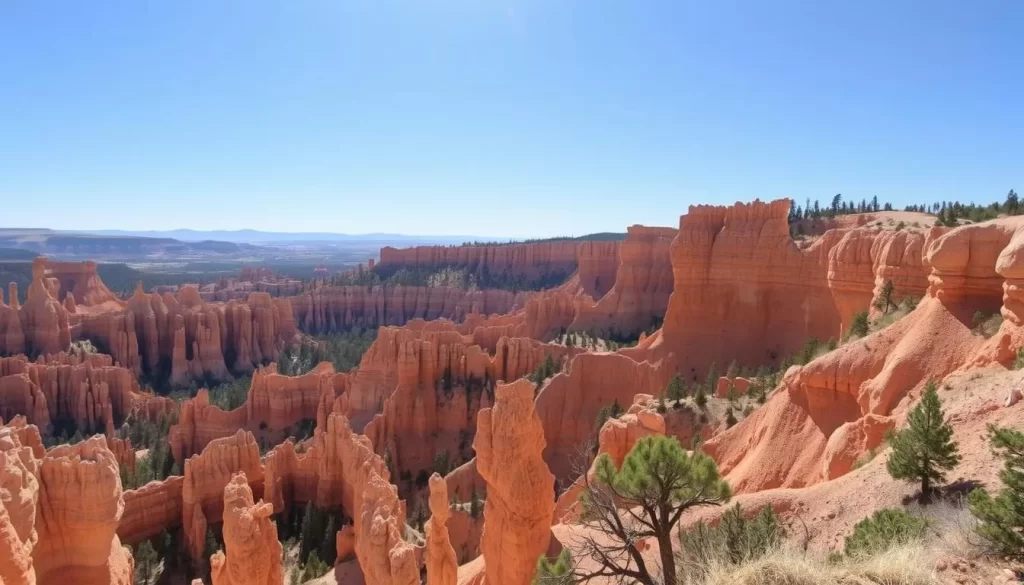
As the most trafficked trail in Bryce Canyon, the Rim Trail provides an unparalleled hiking experience. The Rim Trail is not just any trail; it’s a 5.5-mile journey along the edge of the amphitheater, offering continuous spectacular views of the hoodoos below without the steep elevation changes typical of other trails in the park.
Walking Along the Canyon’s Edge
The Rim Trail in Bryce Canyon National Park is unique because it follows the upper edge of the canyon. This characteristic makes it accessible to a wide range of visitors, including those who may not be ready for the more challenging trails that descend into the canyon. The trail is particularly noted for its panoramic views and the opportunity to see the hoodoos in different lighting conditions throughout the day.
Accessible Sections and Viewpoint Connections
One of the most appealing aspects of the Rim Trail is its accessibility. The paved half-mile section between Sunset and Sunrise Points is wheelchair accessible, making it an ideal option for visitors of all abilities. Furthermore, the trail can be hiked in sections, and with the park shuttle service operating from May through September, visitors can easily return to their starting point.
The Rim Trail also offers flexibility and convenience, with leashed pets permitted on the paved section between Sunset and Sunrise Points. This makes it a great option for families traveling with dogs. For photography enthusiasts, the trail provides endless opportunities to capture the beauty of Bryce Canyon at different times of day.
Adventurous Trails for Experienced Hikers
Bryce Canyon National Park’s diverse landscapes are best experienced through its challenging hikes. For experienced hikers seeking more demanding adventures, the park offers several strenuous trails that showcase its unique landscapes away from the crowds.
Fairyland Loop Trail
The Fairyland Loop Trail is an 8-mile loop that takes hikers through some of the park’s most spectacular and less-visited hoodoo formations, including the Chinese Wall and Tower Bridge. With approximately 1,700 feet of elevation change, this trail is considered strenuous and typically takes 4-5 hours to complete.
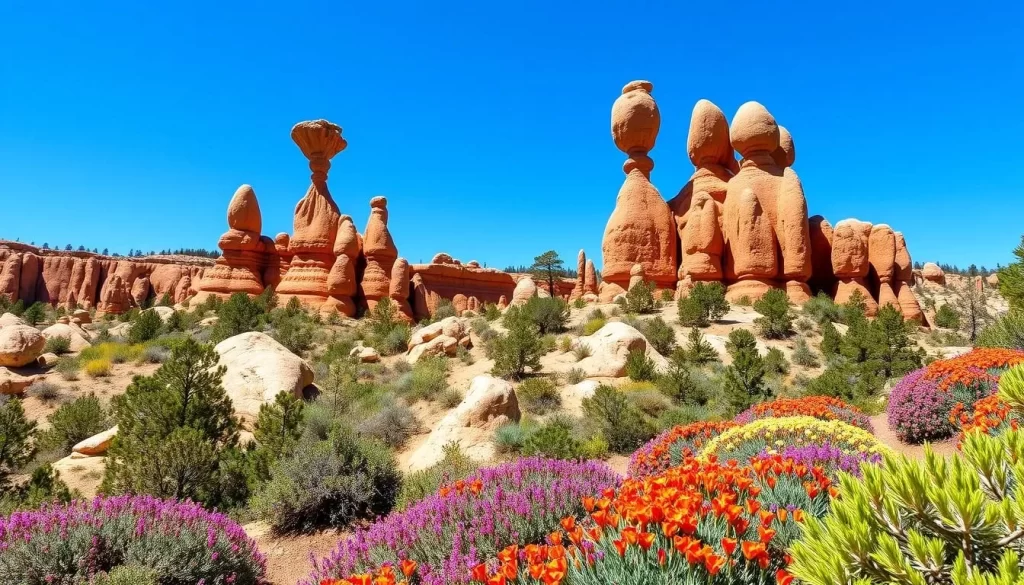
Peek-a-Boo Loop Trail
The Peek-a-Boo Loop Trail is a 5.5-mile round trip adventure that begins at Bryce Point and descends into a forest of hoodoos, featuring the Wall of Windows and other spectacular formations. Often considered more scenic than the more popular Navajo Loop, the Peek-a-Boo Loop sees fewer visitors due to its length and 1,500-foot elevation gain.
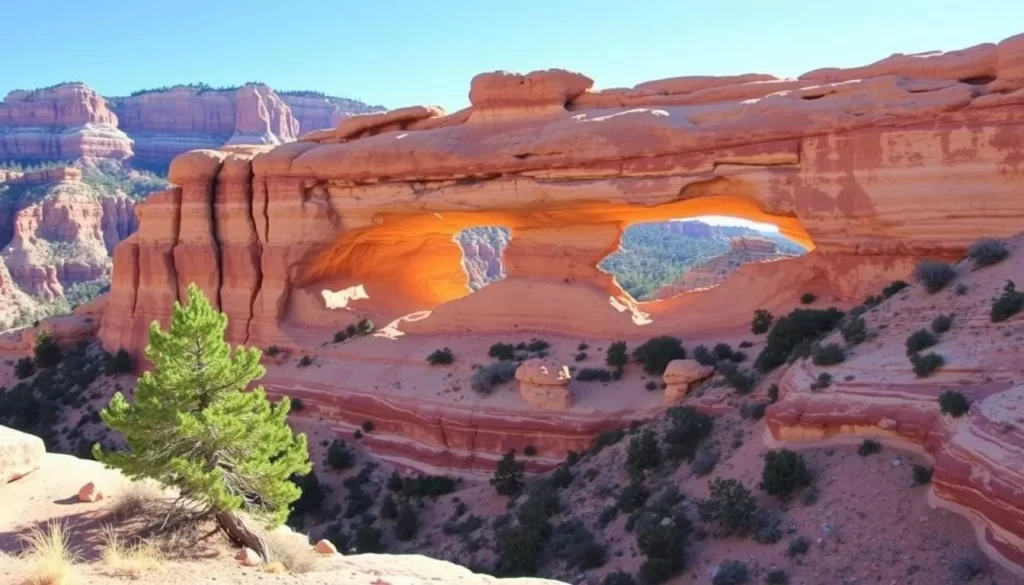
Under-the-Rim Trail for Backpackers
The Under-the-Rim Trail is the park’s premier backpacking route, stretching 22.9 miles from Bryce Point to Rainbow Point and requiring 1-3 days to complete. Backpackers on this trail must obtain a backcountry permit from the Visitor Center and can camp at designated sites along the route.
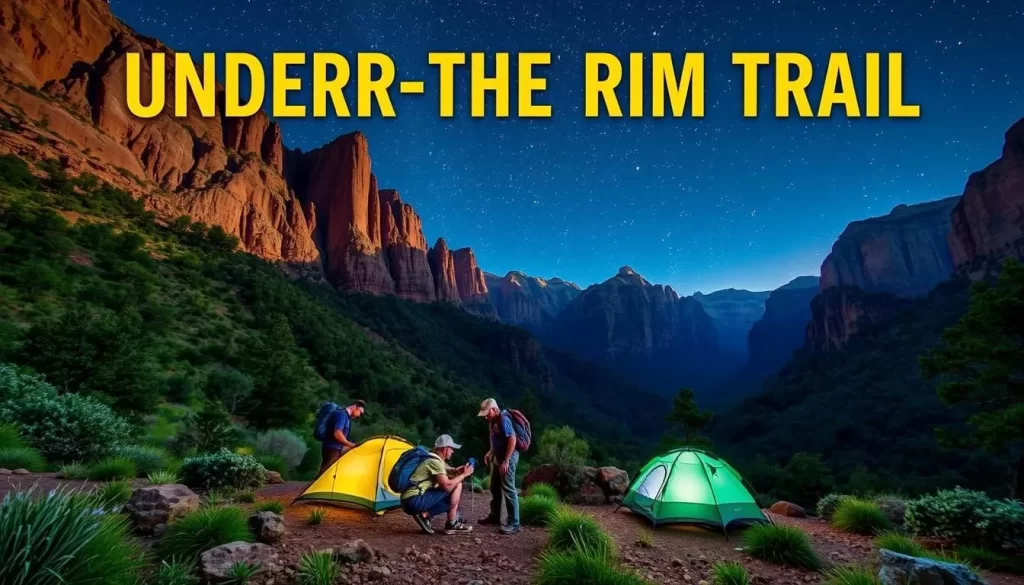
For an epic day hike, experienced hikers can combine the Fairyland Loop with the Rim Trail and parts of the Peek-a-Boo Loop to create a challenging adventure showcasing the best of Bryce Canyon’s diverse landscapes.
Family-Friendly Activities in Bryce Canyon
The beauty of Bryce Canyon National Park is not just in its landscapes, but in the experiences it offers to families. With a range of activities designed for children, the park is an ideal destination for families looking to create lasting memories.
The Mossy Cave Trail Adventure
The Mossy Cave Trail is a favorite among families visiting Bryce Canyon. This 0.9-mile round-trip hike is not only easy but also features a small waterfall and a moss-covered grotto that kids love to explore. Notably, the trailhead is located outside the main park entrance on Highway 12, so you can visit without paying the park entrance fee.
During the summer, the stream along the trail provides a refreshing spot for children to cool off, making it a rare and enjoyable water feature in the park’s otherwise dry landscape.
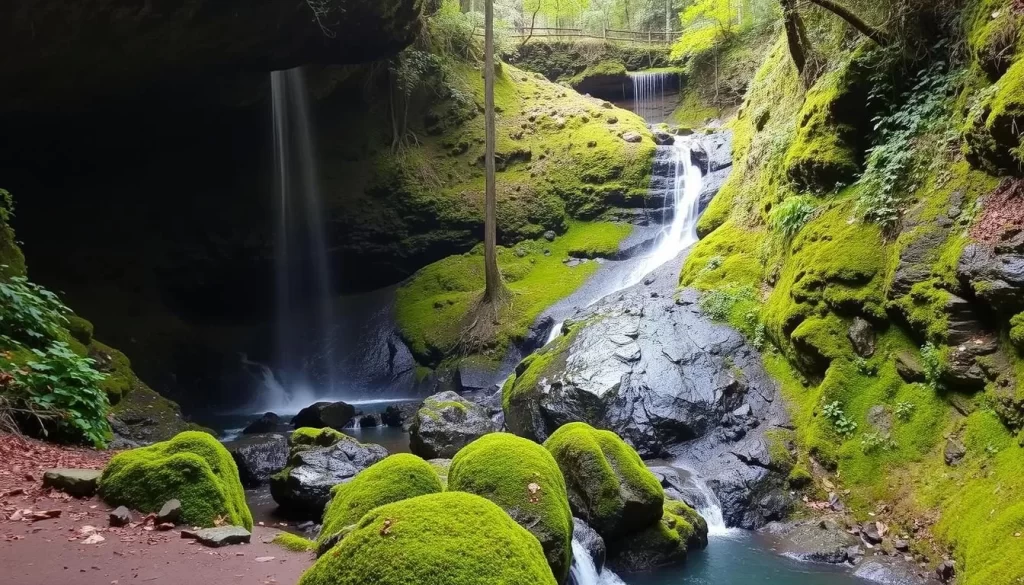
Junior Ranger Program and Educational Opportunities
The Junior Ranger Program is an excellent way for children aged 3 and up to learn about Bryce Canyon National Park. By completing activities in a special booklet available at the Visitor Center, children can be sworn in as official Junior Rangers and receive a badge.
The park also offers ranger-led programs designed for families, including the “Hoodoo Geology Talk” at Sunset Point and “Canyon Rim Walks.” These programs explain the park’s unique features in kid-friendly terms, making the park’s natural wonders accessible to all ages.
The Visitor Center features interactive exhibits on the park’s geology, wildlife, and history, engaging children while teaching them about the park’s unique environment.
Experiencing Bryce Canyon’s Scenic Drive
The scenic drive through Bryce Canyon National Park is an 18-mile journey that showcases the park’s diverse natural beauty. As you drive along this route, you’ll have the opportunity to stop at numerous viewpoints and take in the breathtaking vistas.
18-Mile Main Park Road Highlights
The main park road runs north to south, gradually climbing from the Visitor Center at 8,000 feet to Rainbow Point at 9,115 feet, the highest elevation in the park. For the best experience, drive all the way to Rainbow Point first, then work your way back north, stopping at viewpoints along the way. This approach keeps all pullouts on your right side for easier access.
Must-see stops along the scenic drive include Natural Bridge, a large arch spanning 85 feet, Agua Canyon, featuring “The Hunter” and “Rabbit” hoodoos, and Farview Point, offering views into Arizona on clear days.
| Stop | Feature | Elevation |
|---|---|---|
| Rainbow Point | Panoramic views | 9,115 feet |
| Natural Bridge | Large natural arch | 8,240 feet |
| Agua Canyon | “The Hunter” and “Rabbit” hoodoos | 8,400 feet |
Best Pullouts and Photo Opportunities
Early morning and late afternoon offer the best lighting conditions for photography along the scenic drive, with dramatic shadows enhancing the three-dimensional quality of the landscape. The Rainbow Bus Tour offers free guided tours of the scenic drive twice daily, providing educational commentary and allowing visitors to focus on the scenery rather than driving.
Some of the top viewpoints to stop at include Sunrise, Sunset, Inspiration, and Bryce viewpoints. Make sure to check the current conditions at the Visitor Center, especially during winter months when portions of the scenic drive may be temporarily closed after snowstorms.
Stargazing in an International Dark Sky Park
Gazing at the night sky in Bryce Canyon National Park is a breathtaking experience, thanks to its incredibly dark skies. As an accredited International Dark Sky Park, Bryce Canyon promises world-class stargazing. On a clear night, you may be able to see planets like Jupiter and Venus, as well as a Milky Way that stretches across the sky.
With little to no light pollution from nearby towns, the more desolate regions of the park may fall under the darkest skies you’ve ever seen. To start, we recommend signing up for the park’s “Dark Rangers” stargazing program, which offers a unique opportunity to explore the night sky with expert guidance.
Best Locations and Times for Stargazing
The park’s high elevation and remote location far from major cities create ideal conditions for stargazing. You can see up to 7,500 stars on clear nights, compared to just a few dozen in most urban areas. The best stargazing locations within the park include:
- Sunset Point
- Inspiration Point
- The area around the Visitor Center
These locations offer open views of the sky and convenient parking. Summer and early fall provide the most comfortable temperatures for nighttime stargazing, though winter offers the darkest skies and unique opportunities to see winter constellations.
Ranger-Led Astronomy Programs
The park’s popular ranger-led astronomy programs, conducted by the “Dark Rangers,” include constellation tours, telescope viewing, and educational presentations about light pollution and celestial phenomena. During summer months, the park hosts regular night sky programs and occasional astronomy festivals featuring special guest speakers and additional telescopes.
For the best experience, plan your stargazing around the new moon when the sky is darkest, and allow at least 20-30 minutes for your eyes to fully adapt to the darkness. Bring warm clothing even in summer, as temperatures can drop significantly after sunset due to the park’s high elevation.
Seasonal Activities: Beyond Hiking
Beyond the trails, Bryce Canyon National Park invites you to explore its natural wonders through various seasonal pursuits. As the seasons change, so do the opportunities to experience the park’s unique landscapes.
Horseback Riding Through the Hoodoos
From April to October, horseback riding tours offer a unique perspective on the canyon. You can follow historic trails among the hoodoos with experienced wranglers as guides. Canyon Trail Rides provides 2-hour and half-day horseback tours that descend into the canyon along portions of the Peek-a-Boo Loop, offering a less strenuous way to experience the hoodoo formations up close.

Winter Activities: Snowshoeing and Cross-Country Skiing
During the winter months (November through March), Bryce Canyon transforms into a winter wonderland. You can enjoy snowshoeing and cross-country skiing, with ranger-guided snowshoe hikes available when conditions permit. The 18-mile scenic drive and Rim Trail become excellent routes for cross-country skiing after fresh snowfall, offering a peaceful winter experience.
Biking and E-biking Options
Cycling enthusiasts can enjoy the park’s 5-mile shared-use path that connects the Bryce Canyon shuttle parking area to Inspiration Point. E-bikes (Class 1) are permitted on the same paved surfaces as traditional bicycles, making the park’s hills more accessible. For mountain biking adventures, nearby Red Canyon in Dixie National Forest offers excellent single-track trails.
Whether you’re exploring on horseback, snowshoes, or by bike, Bryce Canyon National Park offers a range of seasonal activities that cater to different interests and abilities. Each season brings its own unique charm and opportunities to experience the park’s natural beauty.
Where to Stay In and Around Bryce Canyon
Bryce Canyon National Park offers various lodging options, both within the park and in nearby communities, catering to different preferences and budgets.
Lodging Inside the Park: Bryce Canyon Lodge and Camping
The historic Bryce Canyon Lodge, a National Historic Landmark built in 1923, is the only non-camping lodging within the park. It features 15 historic cabins, motel rooms, studios, and suites, along with a restaurant, pizzeria, and gift shop. Notably, the lodge does not have TVs, encouraging guests to connect with nature.
For those who prefer camping, the park offers two campgrounds: North Campground with 99 sites and Sunset Campground with 100 sites. Both campgrounds are first-come, first-served, with a cost of $30 per night. There are no sewer, electrical, or water hookups for RVs, but flush toilets and showers are available nearby.
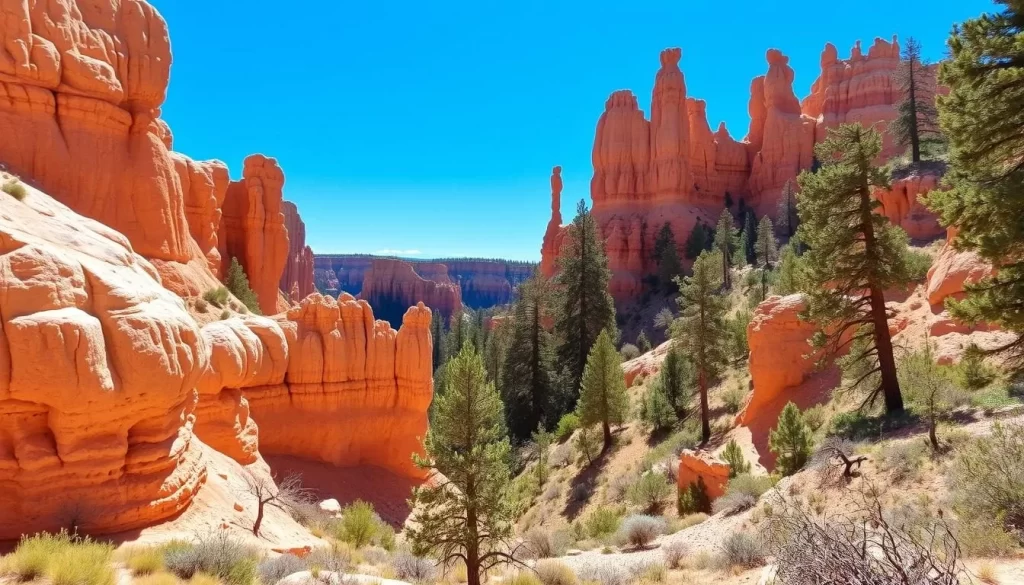
Nearby Accommodations and Amenities
For visitors seeking alternatives to the in-park lodging, Bryce Canyon City and surrounding towns offer a range of accommodations. The Best Western Plus Bryce Canyon Grand Hotel provides comfortable rooms with modern amenities, a complimentary hot breakfast, and indoor and outdoor swimming pools.
Other options include Ruby’s Inn, which has been serving park visitors since 1916 with hotel rooms, an RV park, and various activities. Glamping options are also available at Under Canvas Bryce Canyon and Wander Camp Bryce Canyon, offering luxury tent accommodations.
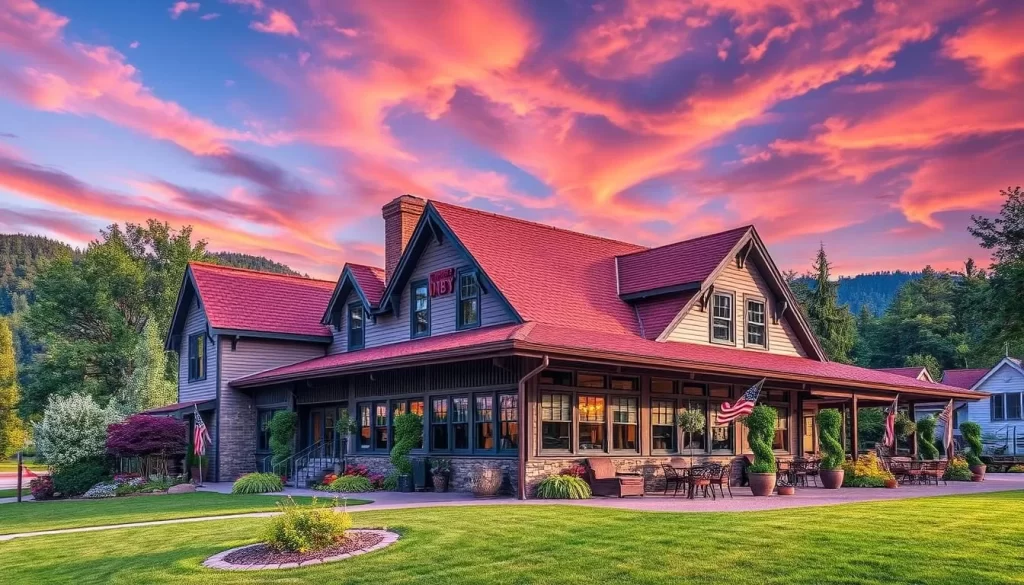
Dining Options and Local Cuisine
You can enjoy a variety of cuisines during your visit to Bryce Canyon National Park, with options ranging from quick bites to full-course meals. Whether you’re looking for a casual meal or a more formal dining experience, Bryce Canyon has something to offer.
Restaurants Within the Park
Within Bryce Canyon National Park, you’ll find several dining options to suit your needs. The historic Bryce Canyon Lodge Dining Room offers breakfast, lunch, and dinner during its operating season, typically from April to November, featuring locally-sourced ingredients and spectacular views. For a more casual meal, the Valhalla Pizzeria & Coffee Shop serves pizza, sandwiches, salads, and coffee drinks, perfect for a quick lunch between hikes.
The General Store near the North Campground provides grab-and-go items, snacks, and basic groceries for those preparing their own meals at campsites. It’s a convenient option for visitors who want to grab a quick bite or stock up on supplies.
Dining in Nearby Communities
Just outside the park, you’ll find additional dining options in Bryce Canyon City and the surrounding areas. Ruby’s Inn features several dining options, including the Cowboy’s Buffet & Steak Room, which serves hearty western fare for breakfast, lunch, and dinner. For a more local experience, the town of Tropic offers several well-regarded restaurants, such as Showdowns Restaurant with live music and Rustler’s Restaurant known for homemade soups and pies.
It’s worth noting that dining options become significantly more limited during the off-season, from November to March, with many restaurants closing entirely. Visitors should plan accordingly and consider accommodations with kitchenettes to ensure they have access to meal options during their stay.
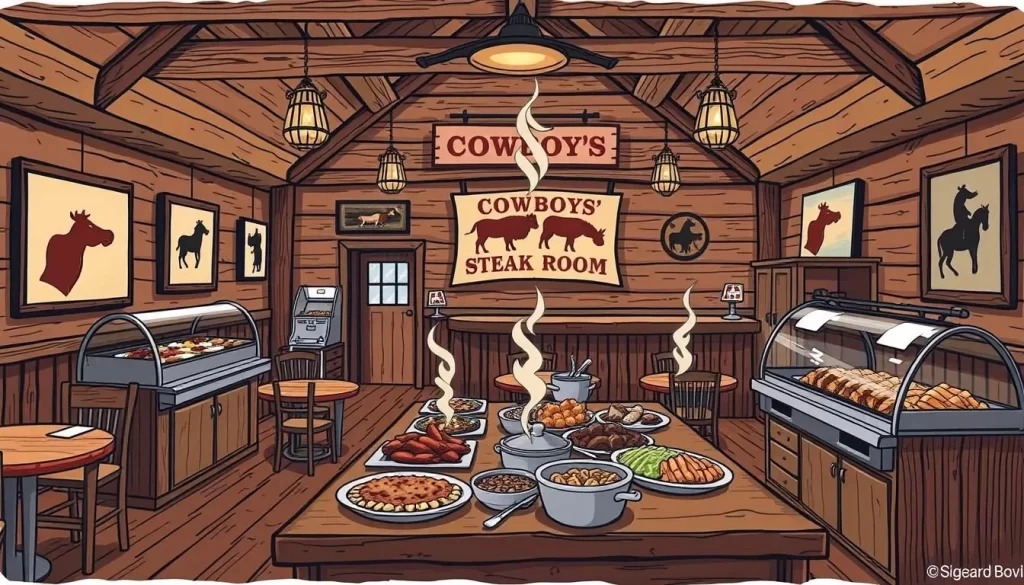
Exploring Beyond Bryce: Nearby Attractions
Beyond the breathtaking vistas of Bryce Canyon National Park lies a world of natural wonders waiting to be explored. The surrounding area is home to a diverse range of attractions that are sure to enhance your Utah adventure.
Red Canyon and Dixie National Forest
Located just 15 miles west of Bryce Canyon on Scenic Byway 12, Red Canyon in Dixie National Forest offers a similar yet distinct experience with its red rock hoodoos and formations. With no entrance fee and fewer crowds, it’s an attractive alternative for those looking to explore beyond Bryce Canyon.
The Pink Ledges-Birdseye-Photo Loop Trail is a 2.2-mile hiking experience that showcases the stunning red rock formations. Suitable for all skill levels, this trail is a great way to immerse yourself in the natural beauty of the area.
Grand Staircase-Escalante National Monument
Grand Staircase-Escalante National Monument is a vast and remote area that covers nearly 1 million acres adjacent to Bryce Canyon. It offers a range of wilderness experiences, including slot canyons, arches, and vast plateaus. The monument is a haven for adventurous hikers, with attractions like the Peek-a-Boo and Spooky Slot Canyons.

Kodachrome Basin State Park
Just 20 miles southeast of Bryce Canyon, Kodachrome Basin State Park is known for its 67 unique sandstone spires, or “sedimentary pipes,” set against multi-colored cliffs. The park offers a range of activities, including camping, hiking, mountain biking, horseback riding, and stargazing. The changing colors of the sandstone chimneys as the sun moves make for a visually stunning experience.
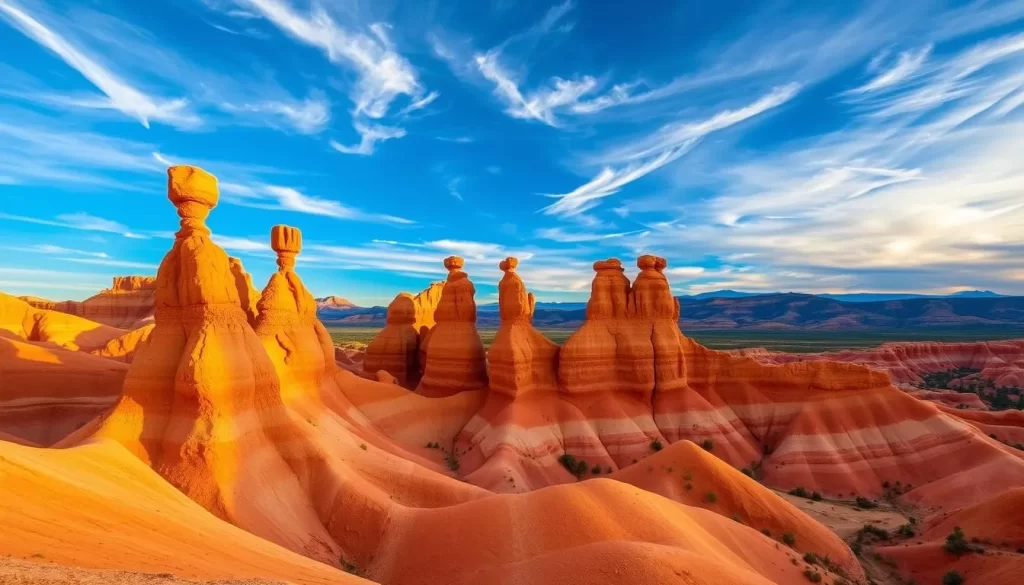
Conclusion: Planning Your Perfect Bryce Canyon Adventure
With its unique hoodoos and breathtaking landscapes, Bryce Canyon National Park is a destination that promises an adventure like no other. The park’s natural beauty is a sight to behold, with its surreal landscape of hoodoos that will leave you in awe.
As you plan your visit, consider the seasonal experiences that Bryce Canyon offers. From hiking among the hoodoos in the summer to snowshoeing through a quiet, snow-covered landscape in winter, there’s something for every season. For first-time visitors, spending at least two full days in the park is recommended to explore the Bryce Amphitheater area and the more remote southern sections.
If your time is limited, prioritize the Navajo Loop and Queen’s Garden combination trail, along with stops at major viewpoints like Sunrise, Sunset, Inspiration, and Bryce Points. For photography enthusiasts, planning your visit around sunrise and sunset will capture the dramatic shadows and intense red-orange colors of the hoodoos.
To avoid crowds, consider visiting during the shoulder seasons (April-May or September-October). Don’t forget to use the free shuttle service operating from May through September to reduce your environmental impact.
Beyond the park, explore nearby attractions like Red Canyon or Kodachrome Basin State Park to appreciate the diverse geology of the Colorado Plateau. With its International Dark Sky Park designation, Bryce Canyon is also an exceptional place for stargazing. Whether you’re seeking adventure, tranquility, or photography opportunities, Bryce Canyon National Park offers a landscape unlike any other.
Plan your visit carefully, and you’ll have an unforgettable experience in this natural wonder.
The above is subject to change.
Check back often to TRAVEL.COM for the latest travel tips and deals.
